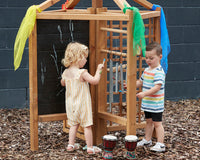In short, to Tune your instrument is to ensure it plays at the correct pitch.
There are two key reasons why tuning your instrument is important. Firstly, to ensure the instrument is in tune with itself and secondly, to ensure it is in tune with others. But what does that really mean to tune your instrument? To get your head around this, it helps to know some key musical terms. Pitch: How high or low something sounds, (i.e - soprano singer = high pitched | bass singer = low pitch.) Note: The name given to a certain pitch in music. Scale: The name given to a certain collection of notes. Flat: A flat (b) note is a semi-tone (half step) lower that it's natural counterpart. This word can also be used to describe any note that sounds lower than it ought. Sharp: A sharp (#) note is a semi-tone (half step) higher that it's natural counterpart. This word can also be used to describe any note that sounds higher than it ought. Clef: A symbol at the start of the stave to indicate the pitch of an instrument.
Pitch: How high or low something sounds, (i.e - soprano singer = high pitched | bass singer = low pitch.) Note: The name given to a certain pitch in music. Scale: The name given to a certain collection of notes. Flat: A flat (b) note is a semi-tone (half step) lower that it's natural counterpart. This word can also be used to describe any note that sounds lower than it ought. Sharp: A sharp (#) note is a semi-tone (half step) higher that it's natural counterpart. This word can also be used to describe any note that sounds higher than it ought. Clef: A symbol at the start of the stave to indicate the pitch of an instrument.
See below the C Major Scale:
 As the notes move higher up the Stave (the lines music notation is written on), the higher in pitch they sound, and vice versa. Between each note is an exact tone (a 'step') or semi-tone (a half 'step.) For example, look at the 'A.' This is the concert pitch note that most bands and orchestras tune up to. This is why you need to tune, especially in a band. If you play your 'A' and it is flat (or sharp) then you are likely at a pitch between the notes either side, or playing another note entirely! As such, you'll clash with others playing the same note.
As the notes move higher up the Stave (the lines music notation is written on), the higher in pitch they sound, and vice versa. Between each note is an exact tone (a 'step') or semi-tone (a half 'step.) For example, look at the 'A.' This is the concert pitch note that most bands and orchestras tune up to. This is why you need to tune, especially in a band. If you play your 'A' and it is flat (or sharp) then you are likely at a pitch between the notes either side, or playing another note entirely! As such, you'll clash with others playing the same note.
- Violin, Viola, Cello, Double Bass
- Classical Guitar, Acoustic Guitar, Bass Guitar
- Piano
Still not getting it?  No worries, read on.
No worries, read on.
Getting Scientific
Tune a Day
When an instrument is out of tune it means that the naturally played pitch of the instrument is either too high or too low. If the pitch is too high, it is considered sharp, if it is too low, then it is flat. This also applies to drums where the membrane (skin/heads) can be loosened or tightened to raise the tone.Did that help?  Excellent, onto the big questions.
Excellent, onto the big questions.
Why does my Instrument go Out of Tune?
Well, there are many factors why an instrument may go out of tune. Some instruments get 'out of tune' with damage or age (warping) when they will no longer play true and have to be repaired. Also changes in temperature and humidity can affect some sensitive instruments. As temperatures fluctuate, instruments may expand or contract. This causes the instrument to go slightly out of tune. On stringed instruments, brand new strings go out of tune quickly at first and need to be 'broken in'. Also, a string obviously can get out of tune if the tuning pegs or tuning devices are bumped or adjusted. A tired embouchure, ill-fitting mouthpiece or problematic technique on wind instruments can also affect the tuning. And finally, Bagpipes… don’t go there! What did I literally just say?
What did I literally just say?How do I tune?
 Every instrument has a method and technique of altering and adjusting the tuning. Strings have pegs, either wooden or geared, that adjust the tension of each string. (Tighten to raise the pitch, loosen to lower.) Whereas wind instruments have slides, mouthpieces or crooks that can be extended or pushed in. Just remember, for wind instruments you push it in (making the instrument smaller,) you raise the pitch and when you pull your, (making the instrument bigger,) you lower the pitch.
Every instrument has a method and technique of altering and adjusting the tuning. Strings have pegs, either wooden or geared, that adjust the tension of each string. (Tighten to raise the pitch, loosen to lower.) Whereas wind instruments have slides, mouthpieces or crooks that can be extended or pushed in. Just remember, for wind instruments you push it in (making the instrument smaller,) you raise the pitch and when you pull your, (making the instrument bigger,) you lower the pitch.
To keep things as easy as can be it might be worth looking into getting a tuner. Is you have a great ear it may be you can use an online tuner that relies on your ability to adjust what you're playing to what you are hearing. For the rest of us mere mortals a digital tuner is the easier (and more accurate!) road to take.






















